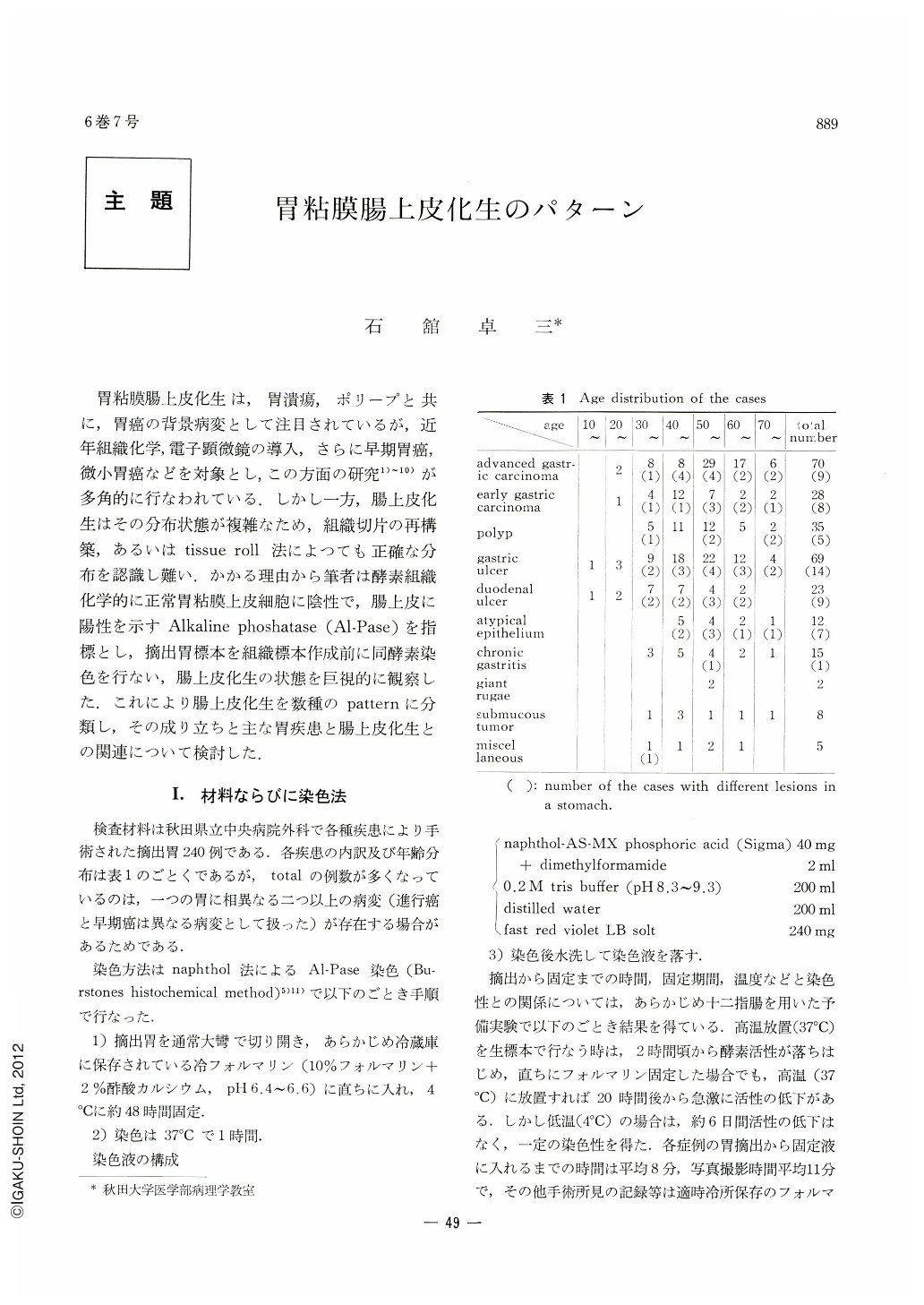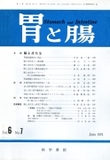Japanese
English
- 有料閲覧
- Abstract 文献概要
- 1ページ目 Look Inside
- サイト内被引用 Cited by
胃粘膜腸上皮化生は,胃潰瘍,ポリープと共に,胃癌の背景病変として注目されているが,近年組織化学,電子顕微鏡の導入,さらに早期胃癌,微小胃癌などを対象とし,この方面の研究1)~10)が多角的に行なわれている.しかし一方,腸上皮化生はその分布状態が複雑なため,組織切片の再構築,あるいはtissue roll法によっても正確な分布を認識し難い.かかる理由から筆者は酵素組織化学的に正常胃粘膜上皮細胞に陰性で,腸上皮に陽性を示すAlkaline phoshatase(Al-Pase)を指標とし,摘出胃標本を組織標本作成前に同酵素染色を行ない,腸上皮化生の状態を巨視的に観察した.これにより腸上皮化生を数種のpatternに分類し,その成り立ちと主な胃疾患と腸上皮化生との関連について検討した.
The surgically resected stomachs, 240 in total, including those removed for carcinoma, ulcer, polyp, etc. were fixed in formalin, and were stained as they were for alkaline phosphatase by the method of Burstone. The distribution of intestinal metaplasia in the gastric mucosa was grossly examined for its pattern and the relation to various gastric diseases.
The patterns of intestinal metaplasia were classified into 6 types: antral, intermediate zone, extensive, diffuse, perifocal and focal. As intestinal metaplasia develops most commonly at the intermediate zone as well as in the antrum on the lesser curvature, the intermediate zone type was found to be of the most frequent patterns of metaplasia. Since most cases having the intermediate zone type manifested higher degree of metaplasia, it seemed likely that this type of metaplasia might have extended from the antral region. However, there were certain cases with an isolated involvement of the intermediate zone by metaplasia, thus suggesting that the induction of metaplasia would occur initially at this region. The extensive and diffuse types were regarded as a sequence of fusion and expansion of the above two types. Differences between the extensive and diffuse types were merely quantitative. The perifocal and focal types were closely related to the localized gastric lesions. The former was frequently seen in cases with ulcer and/or carcinoma. The latter was confined to the lesion manifesting shallow ulceration of superficial depressed type (Ⅱc) of carcinoma.
Intestinal metaplasia was severe and prevalent in stomachs with carcinoma, ulcer and/or polyp. There appears to be several speculations for its origin: (1) Intestinal metaplasia in the stomach with carcinoma and ulcer is a summation of intestinalization due to aging process of the gastric mucosa and that occurring subsequently to associated diseases. (2) Metaplasia could be induced in the course of regeneration of the gastric epithelium. (3) Metaplasia seen in the stomach with polyp is not a pathological change secondary to the polyp, but appears to be a manifestation of atrophic gastritis in that part of the gastric mucosa where polyp has developed. Intestinal metaplasia does not seem to have any direct relation to the induction of polyp.

Copyright © 1971, Igaku-Shoin Ltd. All rights reserved.


